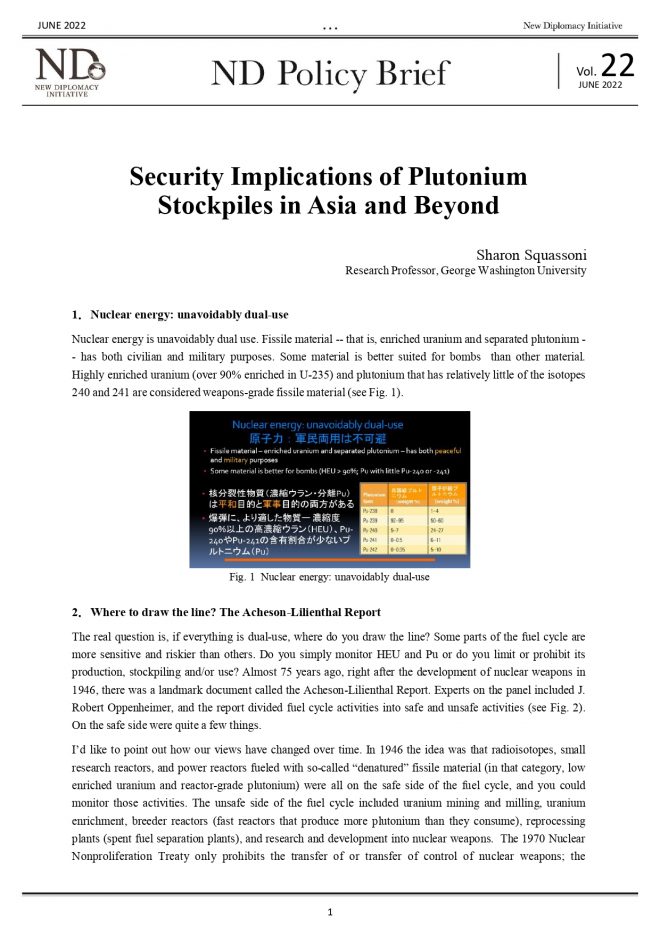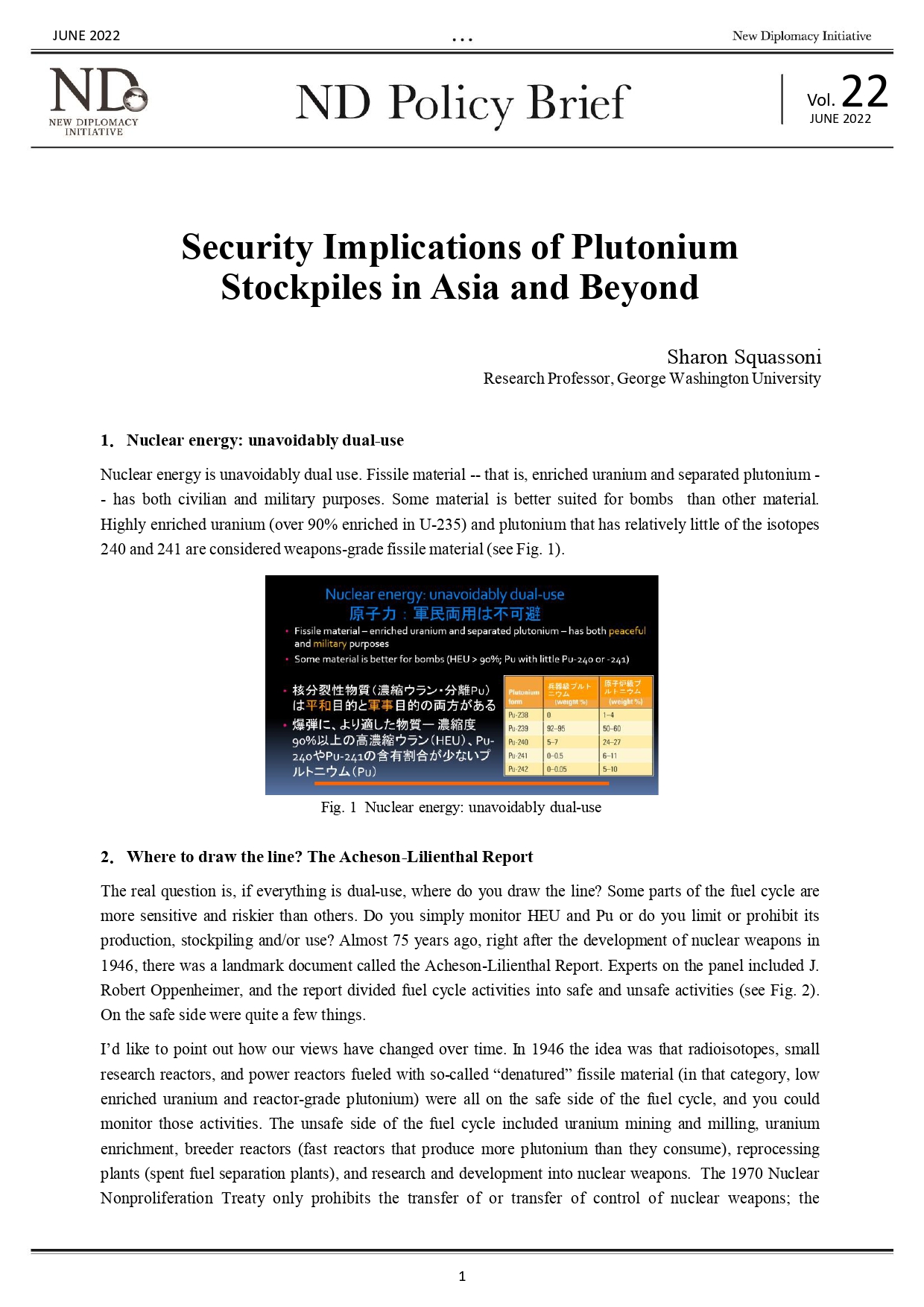Sharon Squassoni
Research Professor, George Washington University
1.Nuclear energy: unavoidably dual-use
Nuclear energy is unavoidably dual use. Fissile material — that is, enriched uranium and separated plutonium — has both civilian and military purposes. Some material is better suited for bombs than other material. Highly enriched uranium (over 90% enriched in U-235) and plutonium that has relatively little of the isotopes 240 and 241 are considered weapons-grade fissile material (Fig. 1, see PDF).
2.Where to draw the line? The Acheson-Lilienthal Report
The real question is, if everything is dual-use, where do you draw the line? Some parts of the fuel cycle are more sensitive and riskier than others. Do you simply monitor HEU and Pu or do you limit or prohibit its production, stockpiling and/or use? Almost 75 years ago, right after the development of nuclear weapons in 1946, there was a landmark document called the Acheson-Lilienthal Report. Experts on the panel included J. Robert Oppenheimer, and the report divided fuel cycle activities into safe and unsafe activities (Fig. 2). On the safe side were quite a few things.
I’d like to point out how our views have changed over time. In 1946 the idea was that radioisotopes, small research reactors, and power reactors fueled with so-called “denatured” fissile material (in that category, low enriched uranium and reactor-grade plutonium) were all on the safe side of the fuel cycle, and you could monitor those activities. The unsafe side of the fuel cycle included uranium mining and milling, uranium enrichment, breeder reactors (fast reactors that produce more plutonium than they consume), reprocessing plants (spent fuel separation plants), and research and development into nuclear weapons. The 1970 Nuclear Nonproliferation Treaty only prohibits the transfer of or transfer of control of nuclear weapons; the manufacture or acquisition of nuclear weapons and seeking or receiving assistance in the manufacture of such weapons. While this may be interpreted as prohibiting R&D into nuclear weapons, the treaty clearly did not conclude that uranium mining and milling, enrichment, breeder reactors or reprocessing plants were too unsafe to engage in nationally.
3.Forgotten lessons
The Acheson-Lilienthal report is mostly remembered for its emphasis on internationalization of nuclear energy, and to reduce the risks from and spread of nuclear weapons. The report was correct about some things, but wrong about others. It correctly predicted the enduring attractiveness of nuclear weapons to states, even just one year after the bombing of Hiroshima and Nagasaki. It also concluded that a vast inspection effort would be necessary in order to ensure the peaceful uses of nuclear energy. Yet, the authors of the report knew that those vast inspections were not possible. That is why they optimistically suggested internationalizing the parts of the fuel cycle deemed “unsafe.” As it turned out, there has been very little internationalization. The Acheson-Lilienthal Report was also completely wrong on the denaturing of plutonium, which cannot be made unusable in a bomb by changing the isotopic composition. The report was right to assume LEU, containing less than 6% U-235, cannot be directly used in a bomb. In fact, US-Russian cooperation to downblend HEU into LEU was predicated on this concept. However, such LEU can be enriched further for use in nuclear weapons and therefore needs to be tracked. Those were the forgotten lessons of the Acheson-Lilienthal report.
What have we learned in the last 75 years? We know that plutonium cannot be denatured. We know that reactor grade plutonium works in a bomb, as the US testing program demonstrated. Fifty-two years ago, the Nuclear Nonproliferation Treaty (NPT) did not prohibit uranium enrichment or spent fuel reprocessing.Just a few short years after, in 1974 when India tested a nuclear weapon, suppliers of nuclear equipment, materials or technology recognized the necessity of halting the spread of enrichment and reprocessing. They established the Nuclear Suppliers Group for that purpose and those efforts continue today.
We learned also that plutonium recycling costs are very high, both for using that fuel in reactors and also increasing the costs for final disposal. Plutonium can be put in mixed oxide fuel (MOX fuel), but spent MOX fuel is going to be even more radioactive than fuel from a thermal, light water reactor.
4.Multilateralization?
On internationalization of the fuel cycle, we have the experience of multinational enrichment and reprocessing in URENCO and Eurochemic. Neither experiment solved proliferation problems. In the case of URENCO, we know very famously that AQ Khan, the so-called father of the Pakistani nuclear bomb, stole supplier information from URENCO, used it for Pakistan’s nuclear weapons program and then further developed a clandestine network of suppliers in the late 1990s and early 2000s. Eurochemic did not have an obvious impact on proliferation of reprocessing technology, but there are fewer technical secrets associated with chemical separation.
5. here are we now?
The current state of negotiations with Iran shows just how weak the NPT is and the Joint Comprehensive Plan of Action (JCPOA), the Iran Deal, shows how much more is necessary. The JCPOA includes limits on stocks, on the level of enrichment, on research and development into more capable centrifuges, and monitoring on centrifuge stockpiles and assembly. These are all necessary to limit a country’s capabilities because the NPT contains no restrictions. On the other hand, we have had norms and standards to minimize highly enriched uranium, under the Nuclear Security Summits. Unfortunately, the latest deal between the US and Australia to share nuclear submarine technology, called AUKUS, shows how limited that norm is. It applies to civilian HEU use, not military use. Encouraging additional countries to use highly enriched uranium for what we call military non-explosive purposes, naval reactors – not bombs but military – shows how narrow the HEU minimization norm is.
On plutonium, there are no restrictions and no international norms to minimize plutonium. The International Plutonium Management Guidelines, INFCIRC/549, constitute a voluntary arrangement among a few states to make declarations on civil stocks. After twenty years of implementation, there is a discrepancy among the countries participating in the kinds of information they provide and no specific formats for declaring information. For example, China has declared very little material, if at all. So there are weaknesses there.
6.Japan is unique
Japan is the only country without nuclear weapons to enrich uranium and reprocess spent nuclear fuel. It is the only non-nuclear weapons state with vast plutonium stocks. Those are two ways in which Japan is unique. It is also among very few countries that have promoted transparency with regard to its nuclear program and nuclear material stockpiles.
7. Historical transparency
Japan has a long history of historical transparency, beginning in 1991 with the adoption of the no surplus plutonium policy. Later in 1994, there was public sharing of information on separated plutonium and plutonium in spent fuel. In 1997, Japan joined the International Plutonium Management Guidelines. The government has slowly gotten a little more involved, providing a little more guidance to industry in terms of their plans for plutonium consumption. In 2018, Japan said for the first time it would reduce stocks and maintain the balance between supply and demand.
8. US current views
The US and Japan have a long history in collaboration on advanced nuclear power, more recently cemented in the US-Japan Climate Partnership which calls for collaboration on advanced nuclear power. Given the Biden Administration’s focus on Asia, the IndoPacific, and positive promotion of nuclear energy, further collaboration is likely in store. Within the US Department of Energy, there has always been a tension between the part of the Department that promotes nuclear energy (Office of Nuclear Energy) and the part that has to deal with the consequences of that – the National Nuclear Security Agency (NNSA), now headed by former Sandia laboratory official Jill Hruby. NNSA is likely concerned about plutonium stockpiles and reprocessing, but must contend with the Office of Nuclear Energy’s support for the benefits of reprocessing for advanced reactors. The US, despite many years of not engaging in reprocessing, is now considering it for the purpose of recycling fuel for advanced reactors.
9. The role of US Congress
Congress has little formal role in many of these issues, since the US-Japan Nuclear Cooperation Agreement has been extended indefinitely and requires no further oversight from Congress. However, this does not mean that members of Congress will not be sensitive to how Japan’s actions regarding plutonium and reprocessing may affect other areas. One of those will certainly be US-South Korea nuclear cooperation. In the area of defense and security, the Congress and the Biden administration are very concerned about China’s nuclear modernization. The latest estimates that China could triple its stockpile depend on an assumption that China either has a lot of fissile material lying around, or that it will make fissile material in its breeder reactors. The potential for Japan to do the same, and for South Korea and North Korea to follow suit, are clear. Finally on North Korea, congressmen may ask whether an increasing plutonium stockpile in Japan makes regional security better or worse in the eyes of North Korea.
10. Recommendations
Japan has an opportunity to lead in East Asia. Some ideas that have arisen in the course of my research from regional experts include the following: Japan could build interim storage; it could make progress on a repository for spent fuel; it could suggest, promote or propose a regional moratorium on reprocessing; it could get involved in creating an international storage for plutonium; or it could swap ownership of plutonium to use it up more quickly. Lastly, Japan could be a leader in efforts to create real restraints on supply to meet demand.
※This paper is based on the author’s presentation at the international symposium “Growing Plutonium Stockpiles and the Rokkasho Reprocessing Plant: Reality of Nuclear Fuel Cycle and Security in East Asia” , Dec. 18-19, 2021. The views expressed here are those of the author.
※This project is supported by a grant from “act beyond trust” (abt) .




